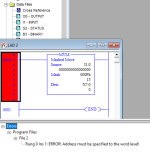Hello,
I'm involved in the programming of a conveyor tripper.
For those who are not sure what this is.
See this video:
https://www.youtube.com/watch?v=LI_Kgbr5kc4
This tripper will have 4 different locations to dump material.
We plan to use a 4 way selector switch for the operator to decide witch location the moving cart needs to dump
We're are using proximity sensors to detect the 4 different location, "we are not using encoders". These proximity sensors are installed on the moving cart and not at the different locations.
Example:
If the cart is at location 1 and the operator selects location 4. The cart must not stop at location 2 or 3. it must continue moving to location 4. I'm assuming we need to use combination of counters and math instructions? If it need to go back to location 1 how will it know to go into "reverse"
Can anyone assume or foresee any problems with this setup?
Or should we make the recommendation to have the sensors installed at the locations? would it facilitate the programming?
Can someone provide ideas or examples for the programming on this?
*We're using Micrologix 1400 and RSlogix
*And we are not using a VFD for the motor just a size 0 motor starter with a contactor.
I'm involved in the programming of a conveyor tripper.
For those who are not sure what this is.
See this video:
https://www.youtube.com/watch?v=LI_Kgbr5kc4
This tripper will have 4 different locations to dump material.
We plan to use a 4 way selector switch for the operator to decide witch location the moving cart needs to dump
We're are using proximity sensors to detect the 4 different location, "we are not using encoders". These proximity sensors are installed on the moving cart and not at the different locations.
Example:
If the cart is at location 1 and the operator selects location 4. The cart must not stop at location 2 or 3. it must continue moving to location 4. I'm assuming we need to use combination of counters and math instructions? If it need to go back to location 1 how will it know to go into "reverse"
Can anyone assume or foresee any problems with this setup?
Or should we make the recommendation to have the sensors installed at the locations? would it facilitate the programming?
Can someone provide ideas or examples for the programming on this?
*We're using Micrologix 1400 and RSlogix
*And we are not using a VFD for the motor just a size 0 motor starter with a contactor.
Last edited:






